Rubber cuff for toilet (eccentric): installation and connection rules
Connecting a toilet to a sewer does not require special knowledge and skills, however, during installation you may encounter difficulties in the form of a mismatch between the central axes of the outlet of the plumbing fixture and the sewer drain pipe.
Holes that are at different levels or shifted to the side can be connected using a toilet cuff - eccentric or corrugated.
We'll show you how to choose the right product and install it. There are no particular difficulties, the main thing is to take into account the design of the toilet itself and follow the instructions given below. To make the task easier and improve understanding of the installation process, we have supplemented the information with visual photographs and thematic videos.
The content of the article:
Classification of toilet cuffs
The cuff is a simple but necessary plumbing element responsible for the tight connection of the toilet to the sewer outlet. It is mandatory when installing any type of floor-standing appliance. This means that when choosing a compact toilet and purchasing it, you must immediately purchase a cuff.
Commercially available parts differ in material, diameter, and shape, so before purchasing you should find out some connection points. For example, you need to know the diameter of the sewer pipe to which one end of the cuff will be attached.The standard is D 110 mm, but deviations from the norm may occur.
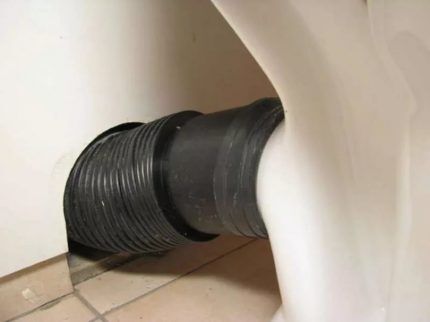
You should also clarify the type of toilet outlet and its diameter, since the second end of the cuff will be attached to it. Size mismatch possible.
The problem is solved by using one of the types of cuff:
- with direct connection - simple cone model;
- when connected with offset - combined with different sizes of outlets.
In difficult cases, when the toilet with sewer outlet are at different levels relative to the floor or are displaced along the axis, it is easier to use a more elastic type of cuff - a corrugated pipe, which has two smooth tips and a flexible central part that can stretch, change its shape and length.
So, if we summarize all types of cuffs, we can distinguish the following groups:
- straight smooth;
- corner smooth;
- conical;
- eccentrics;
- corrugated.
You can find combined types - for example, smooth straight on one side, corrugated on the other.

Based on the material used, all cuffs are divided into two groups:
- Plastic. Suitable for modern models of toilets and plastic sewer pipes.
- Rubber. Used to connect to a cast iron pipe.
The color of the material does not mean anything; manufacturers usually produce white, gray or black products.
Selecting an Outlet-Oriented Adapter
In addition to the dimensions, which are of paramount importance, it is also necessary to take into account the design features of the toilet, namely the release form.
It comes in three types:
- vertical;
- horizontal;
- oblique.
Vertical release
In Russia it is used extremely rarely, since the location of sewer pipes above the floor level contradicts such a device. The vertical outlet is designed so that the sewer drain is at floor level, and the pipes themselves are sewn into the ceiling or placed under the floor covering.
If installation is still required toilet with vertical outlet, then it is appropriate to use a straight, short, cylindrical plastic cuff. No eccentrics or complex configurations are required because the vertical outlet toilet is placed directly above the sewer outlet.
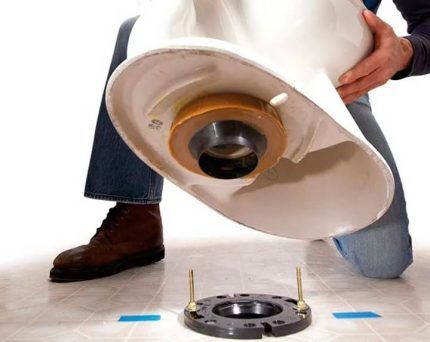
Horizontal release
This option is much more common and is a toilet element directed perpendicular to the wall. Ideally, it should be located just opposite the inlet of the sewer pipe.
In this case, a smooth plastic cuff of short length or an element with two cylinders at the edges and a corrugated middle will do.
If the house is old and the pipes have not yet been changed (a rare case), then you will need a rubber cuff for the compact toilet, which is used to connect to cast iron pipes.When the input-output axes shift in height, an eccentric is useful - either smooth or with a corrugated pipe.
If the distance to the pipe is significant, sometimes a corrugation is used, stretching it to the required length, and an eccentric for a more airtight connection.

As you can see, when connecting a plumbing fixture with a horizontal outlet, various types of cuffs can be used.
Oblique release
Such toilets are also connected in different ways, depending on their location relative to the sewer drain.
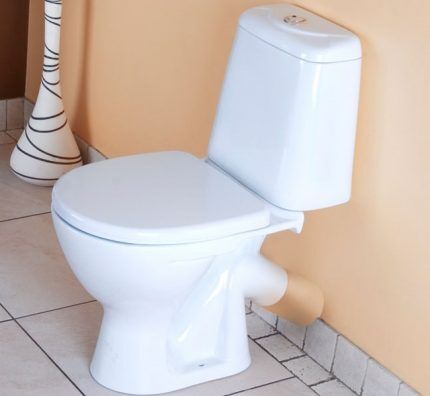
If the entrance/exit is located on the same level, it is better to buy a plumbing fixture with a horizontal outlet.
At connecting the oblique outlet Short plastic cylindrical elements are also suitable if the toilet is mounted next to a pipe, and longer products with corrugation if the plumbing fixture is located at some distance from the sewer drain hole.
A rubber cuff is also necessary only in one case - if you need to connect the toilet to an old-style cast iron pipe.
Installation instructions for various types of cuffs
The principle of fixing rubber or plastic, smooth or corrugated parts is similar, but the process itself may differ in nuances - from choosing the location of the toilet to using additional fastening methods. Let's look at three common connection options.
#1: Installing the rubber seal
A rubber cuff is a short, dense element that is not pulled from the outside, but is inserted into the socket of a cast iron pipe. This is a kind of seal or gasket that creates an airtight connection between the drain hole and the plumbing fixture.
In addition, it protects sanitaryware from chipping and damage in case of unintentional violation of the stability of installation.
Procedure for installing the rubber cuff:
If the toilet outlet fits into the socket freely, then a soap solution will not be needed. On the contrary, it is necessary to create a tighter junction.
For this, a traditional modern method is usually used - sealant is applied over the entire surface of the adjacent parts.After hardening, it forms a tight, hermetically sealed ring.
#2: Rules for using the eccentric
You will learn that you will need an eccentric at the stage of choosing a place to install the toilet. If the outlet hole of the plumbing fixture and the socket of the sewer pipe are not exactly opposite each other, a simple plastic connector is not enough. Offset axes require a curved part.
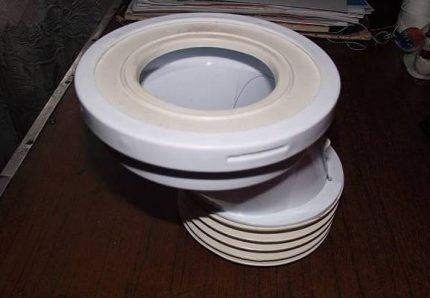
Before installation, you need to put the plumbing fixture in place, measure the length to the sewer drain and once again make sure that the eccentric model for the toilet is selected correctly. To check, you can simply place the part against both holes.
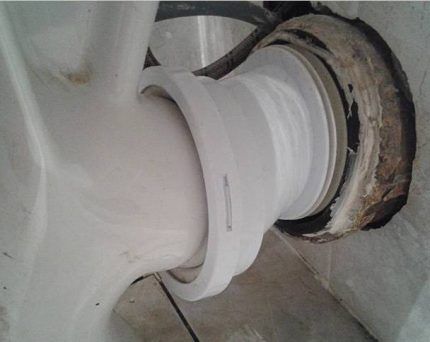
Work order:
- we clean the sewer inlet from old sediments;
- We put the cuff with the wide end (110 mm) onto the sewer socket, coating the junction points with sealant;
- we attach the second end to the oblique or horizontal outlet of the toilet, also using sealant;
- We carry out a test drainage of water;
- If no leaks are found, we fix the toilet in a previously prepared place with bolts.
The problem arises when, during installation, it turns out that the eccentric is selected incorrectly. To avoid an uncomfortable situation, instead of a rigid structure, you can immediately buy a part with an elastic corrugated middle.
As necessary, the eccentric with an accordion can be slightly shifted to the right/left or stretched a little, while maintaining its functional qualities.

Movable parts are also relevant when there is a risk of the toilet being loosely secured. Simply put, when the plumbing fixture is shaken, the tightness of the rigid connection will immediately be broken, while this will not threaten the corrugation.
#3: Installing the bellows
When it is difficult to install a toilet due to an unsuitable outlet shape or a complex location of the sewer system, an elastic corrugated pipe is often used. Its advantage is that it can easily change shape and length, therefore it is suitable for almost all types of releases.
The only thing that needs to be taken into account when purchasing is the diameters of the fixing cylindrical ends. They can be 110 mm/90 mm, 110 mm/80 mm, etc.
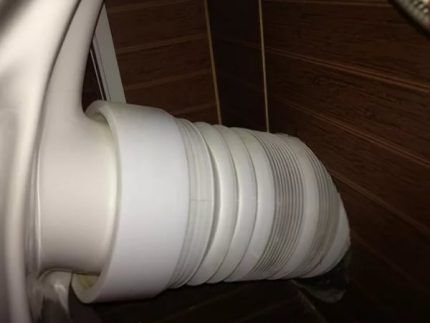
The principle of replacement or corrugation installations the same as other types of cuffs:
- removal of the old worn element;
- cleaning inlets from dirt and deposits;
- inserting the end treated with sealant into the sewer socket;
- fixing the second end to the toilet outlet;
- test drainage of water, elimination of shortcomings.
Experienced plumbers recommend not stretching the corrugation to the maximum, since as a result it loses its elasticity and fails faster.
It is better to choose a longer model or try to move the toilet closer to the sewer outlet. Another option is to purchase a combined cuff, consisting partly of rigid elements.
Tips for attaching adapters
Before choosing a cuff, be sure to check the distance from the toilet outlet to the sewer pipe. Sometimes the installation process is disrupted only because the length of the eccentric is 2 cm less than necessary.

Elongated corrugation is prone to sagging, so additional fasteners will be required to give it a straight look. Sharp corners and strong bends are the causes of frequent blockages.
In addition to the length and shape of the cuffs, pay attention to the thickness of the walls. The higher this indicator, the longer the device will last.
Before purchasing plumbing fixtures, analyze the condition of the sewer system, and then you can choose a model with the desired type of outlet and decide on toilet installation diagram.
Conclusions and useful video on the topic
You can learn about the secrets of the correct selection and use of plumbing cuffs from the following videos.
Usage for connecting the corner cuff:
Plumbing tricks when using adapters and cuffs:
Attaching the cuff is part of the toilet installation process. If you choose the right connecting element, installing plumbing will not take much time and will not cause difficulties.
If you encounter any difficulties, we recommend that you seek help from specialists. A timely consultation before purchasing a cuff will also not hurt.
Do you have practical skills in installing, connecting a toilet and installing a cuff? Please share your accumulated knowledge or ask questions on the topic in the comments. The communication block is located below.




I have a corrugation on my toilet bowl. I thought about changing it, but why? It copes with its tasks, water does not leak anywhere, everything is tight and insulated. For me, there is no difference at all, the main thing is that it is convenient to install and dismantle if necessary.
In such cases, I am once again convinced of the proverb: “There is nothing more permanent than temporary.” But corrugation is not a temporary solution; to be honest, the service life it contains is at least ten years. If you do not violate the installation rules, then no problems should arise. For example, when installing a toilet, the length of the corrugation is not enough and it is stretched to the maximum, which significantly reduces its elasticity properties. There is no need to do this, it is better to buy with a margin of length.
And another classic from the “it will do” genre, when they didn’t guess with the diameters and people start making a bunch of incomprehensible adapters. I'm attaching a photo of how to do it, it's definitely not worth it!
Everything must be done correctly. In general, the fewer connections the better and do not allow 90 turns * this leads to blockages